Using Shortwave Radiation to Evaluate the HARMONIE-AROME Weather Model
Abstract
:1. Introduction
2. Datasets/Models
2.1. Observation Networks
2.1.1. The Irish Network
2.1.2. The Danish Network
2.2. Models
2.2.1. MÉRA
2.2.2. Danish Model Runs
3. Results
3.1. GHI Statistics
3.2. Clear Sky Index
3.3. Variability Index
4. Discussion
5. Conclusions
Author Contributions
Acknowledgments
Conflicts of Interest
References
- Boilley, A.; Wald, L. Comparison between meteorological re-analyses from ERA-Interim and MERRA and measurements of daily solar irradiation at surface. Renew. Energy 2015, 75, 135–143. [Google Scholar] [CrossRef] [Green Version]
- Martucci, G.; Milroy, C.; O’Dowd, C.D. Detection of Cloud-Base Height Using Jenoptik CHM15K and Vaisala CL31 Ceilometers. J. Atmos. Ocean. Technol. 2010, 27, 305–318. [Google Scholar] [CrossRef]
- De Rooy, W. Royal Netherlands Meteorological Institute (KNMI), De Bilt, Netherlands. Personal communication, 2015. [Google Scholar]
- Perez, R.; Ineichen, P.; Seals, R.; Zelenka, A. Making full use of the clearness index for parameterizing hourly insolation conditions. Sol. Energy 1990, 45, 111–114. [Google Scholar] [CrossRef]
- Skartveit, A.; Olseth, J.A.; Tuft, M.E. An hourly diffuse fraction model with correction for variability and surface albedo. Sol. Energy 1998, 63, 173–183. [Google Scholar] [CrossRef]
- Savijärvi, H. Fast radiation parameterization schemes for mesoscale and short-range forecast models. J. Appl. Meteorol. 1990, 437–447. [Google Scholar] [CrossRef]
- Gleeson, E.; Nielsen, K.P.; Toll, V.; Rontu, L.; Whelan, E. Shortwave Radiation Experiments in HARMONIE. Tests of the cloud inhomogeneity factor and a new cloud liquid optical property scheme compared to observations. ALADIN-HIRLAM Newsl. 2015, 5, 92–106. [Google Scholar]
- Stein, J.; Hansen, C.; Reno, M. The Variability Index: A New and Novel Metric for Quantifying Irradiance and PV Output Variability. In Proceedings of the WREF Conference, Denver, CO, USA, 13–17 May 2012. [Google Scholar]
- Irish Meteorological Service. Solar Radiation Observations 1982; Irish Meteorological Service: Dublin, Ireland, 1983.
- Laursen, E.V.; Rosenørn, S. Landstal af Solskinstimer for Danmark; 1920–2002; Tech. Report, 03-19; Danish Meteorological Institute: Copenhagen, Denmark, 2003.
- Gleeson, E.; Whelan, E.; Hanley, J. Met Éireann high resolution reanalysis for Ireland. Adv. Sci. Res. 2017, 14, 49–61. [Google Scholar] [CrossRef]
- Whelan, E.; Gleeson, E.; Hanley, J. An evaluation of MÉRA, a high resolution mesoscale regional reanalysis. JAMC submitted. 2018. [Google Scholar]
- Fischer, C.; Montmerle, T.; Berre, L.; Auger, L.; Ştefănescu, S.E. An overview of the variational assimilation in the ALADIN/France numerical weather-prediction system. Q. J. R. Meteorol. Soc. 2005, 613, 3477–3492. [Google Scholar] [CrossRef]
- Brousseau, P.; Berre, L.; Bouttier, F.; Desroziers, G. Background-error covariances for a convective-scale data-assimilation system: AROME-France 3DVar. Q. J. R. Meteorol. Soc. 2011, 137, 409–422. [Google Scholar] [CrossRef]
- Seity, Y.; Brousseau, P.; Malardel, S.; Hello, G.; Bénard, P.; Bouttier, F.; Lac, C.; Masson, V. The AROME-France Convective-Scale Operational Model. Mon. Weather Rev. 2011, 139, 976–991. [Google Scholar] [CrossRef]
- Bengtsson, L.; Andrae, U.; Aspelien, T.; Batrak, Y.; Calvo, J.; de Rooy, W.; Gleeson, E.; Sass, B.H.; Homleid, M.; Hortal, M.; et al. The HARMONIE–AROME Model Configuration in the ALADIN–HIRLAM NWP System. Mon. Weather Rev. 2017, 145, 1919–1935. [Google Scholar] [CrossRef]
- Masson, V.; Le Moigne, P.; Martin, E.; Faroux, S.; Alias, A.; Alkama, R.; Belamari, S.; Barbu, A.; Boone, A.; Bouyssel, F.; et al. The SURFEXv7. 2 land and ocean surface platform for coupled or offline simulation of earth surface variables and fluxes. Geosci. Model Dev. 2013, 6, 929–960. [Google Scholar] [CrossRef] [Green Version]
- Dee, D.P.; Uppala, S.M.; Simmons, A.J.; Berrisford, P.; Poli, P.; Kobayashi, S.; Andrae, U.; Balmaseda, M.A.; Balsamo, G.; Bauer, P.; et al. The ERA-Interim reanalysis: Configuration and performance of the data assimilation system. Q. J. R. Meteorol. Soc. 2011, 137, 553–597. [Google Scholar] [CrossRef]
- Yang, X.; Andersen, B.S.; Dahlbom, M.; Sass, B.H.; Zhuang, S.; Amstrup, B.; Petersen, C.; Nielsen, K.P.; Nielsen, N.W.; Mahura, A. NEA, the Operational Implementation of HARMONIE 40h1.1 at DMI. ALADIN-HIRLAM Newsl. 2017, 8, 104–111. [Google Scholar]
- Masson, V. The Externalized Surface User’s Guide v7.3; Tech. Report; Meteo France: Toulouse, France, 2016; Available online: http://www.umr-cnrm.fr/surfex/spip.php?rubrique10 (accessed on 21 February 2018).
- Nielsen, K.P.; Gleeson, E.; Rontu, L. Radiation sensitivity tests of the HARMONIE 37h1 NWP model. Geosci. Model Dev. 2014, 7, 1433–1449. [Google Scholar] [CrossRef]
- Cuxart, J.; Bougeault, P.; Redelsperger, J.-L. A turbulence scheme allowing for mesoscale and large-eddy simulations. Q. J. R. Meteorol. Soc. 2000, 126, 1–30. [Google Scholar] [CrossRef]
- Lenderink, G.; Holtslag, A. An updated length-scale formulation for turbulent mixing in clear and cloudy boundary layers. Q. J. R. Meteorol. Soc. 2004, 130, 3405–3427. [Google Scholar] [CrossRef]
- Tanre, D.; Geleyn, J.; Slingo, J. First Results of the Introduction of an Advanced Aerosol-Radiation Interaction in the ECMWF Low Resolution Global Model. Aerosols and their climatic effects. In Aerosols and Their Climatic Effects: Proceedings of the Meetings of Experts, Williamsburg, Virginia, 28–30 March 1983; Gerber, H.E., Deepak, A., Eds.; A Deepak Publishing: Hampton, VA, USA, 1984; pp. 133–177. [Google Scholar]
- Tegen, I.; Hollrig, P.; Chin, M.; Fung, I.; Jacob, D.; Penner, J. Contribution of different aerosol species to the global aerosol extinction optical thickness: Estimates from model results. J. Geophys. Res. Atmos. 1997, 102, 23895–23915. [Google Scholar] [CrossRef]
- Gleeson, E.; Toll, V.; Nielsen, K.P.; Rontu, L.; Mašek, J. Effects of aerosols on clear-sky solar radiation in the ALADIN-HIRLAM NWP system. Atmos. Chem. Phys. 2016, 16, 5933–5948. [Google Scholar] [CrossRef]
- Toll, V.; Gleeson, E.; Nielsen, K.P.; Männik, A.; Mašek, J.; Rontu, L.; Post, P. Impacts of the direct radiative effect of aerosols in numerical weather prediction over Europe using the ALADIN-HIRLAM NWP system. Atmos. Res. 2016, 172–173, 163–173. [Google Scholar] [CrossRef]
- Roesch, A.; Wild, M.; Ohmura, A.; Dutton, E.G.; Long, C.N.; Zhang, T. Assessment of BSRN radiation records for the computation of monthly means. Atmos. Meas. Tech. 2011, 4, 339–354. [Google Scholar] [CrossRef] [Green Version]
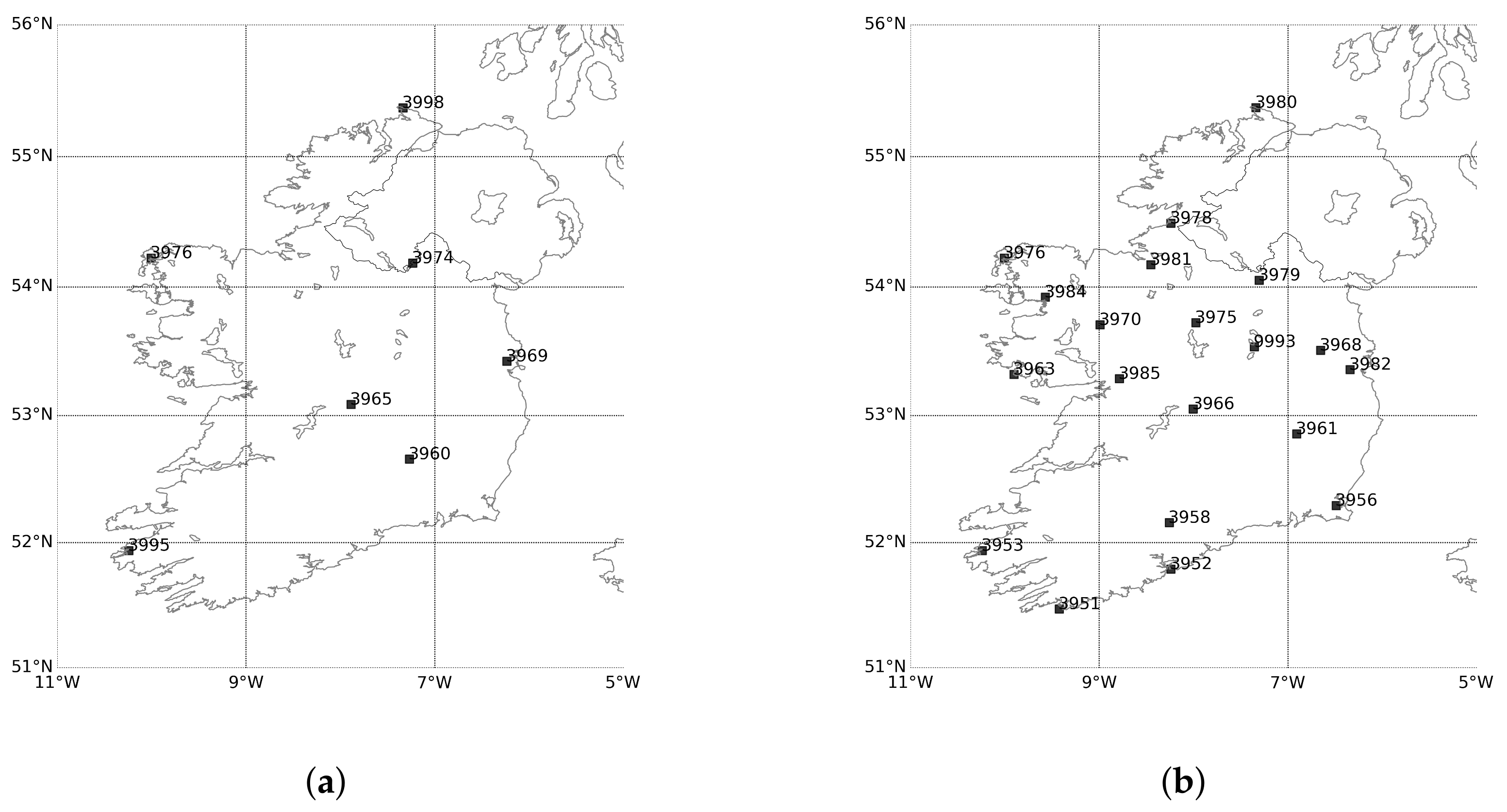

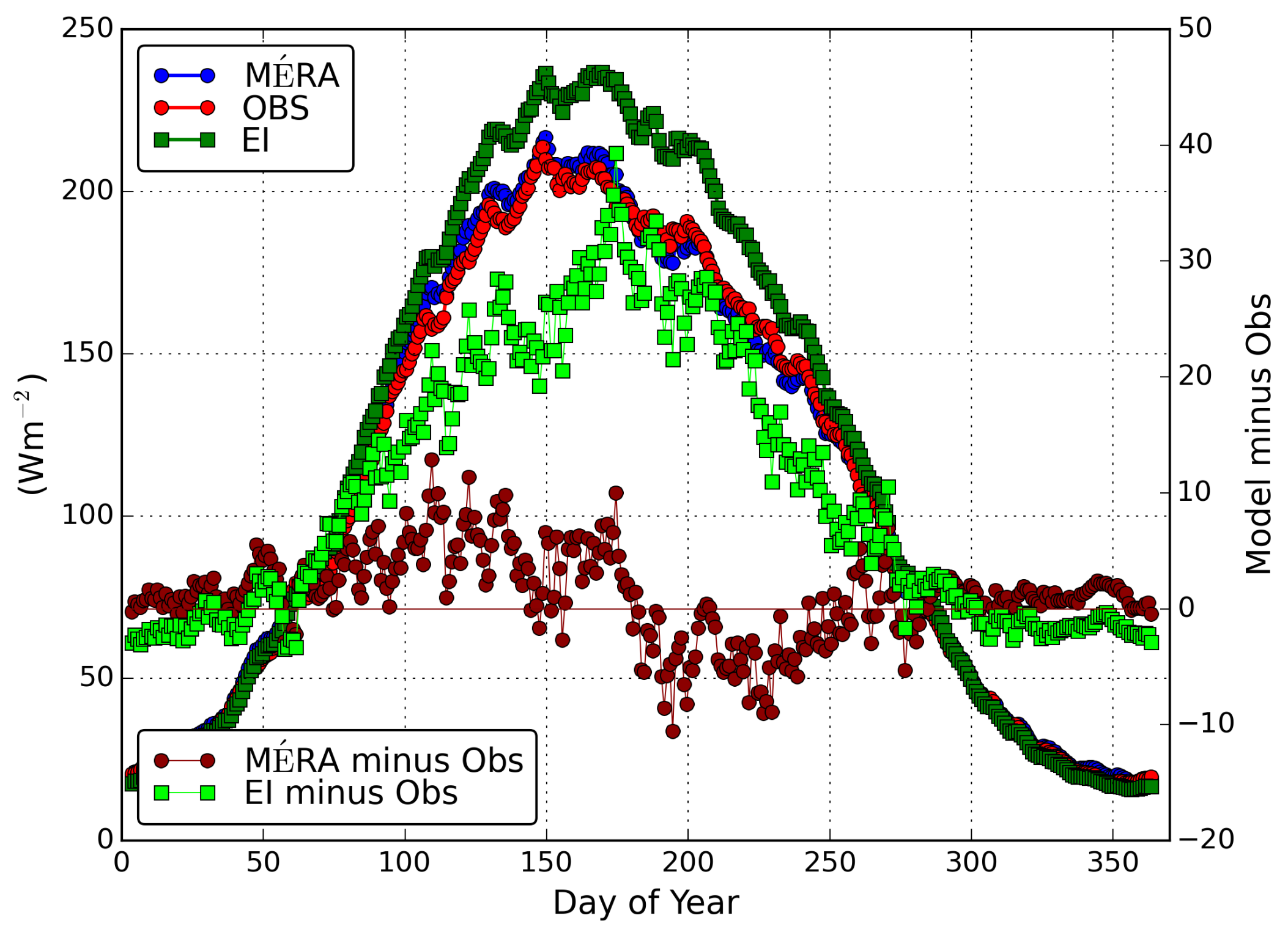
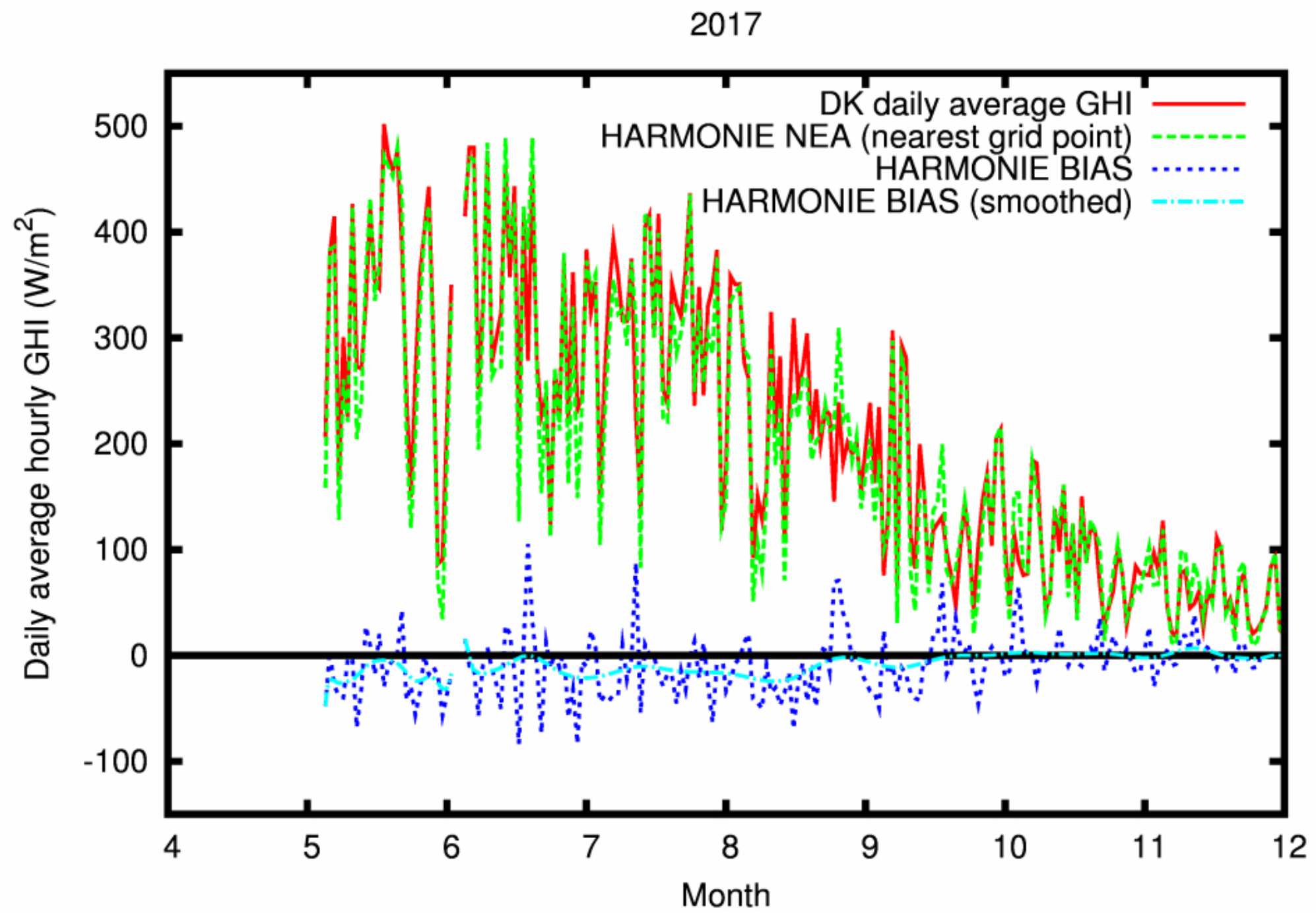
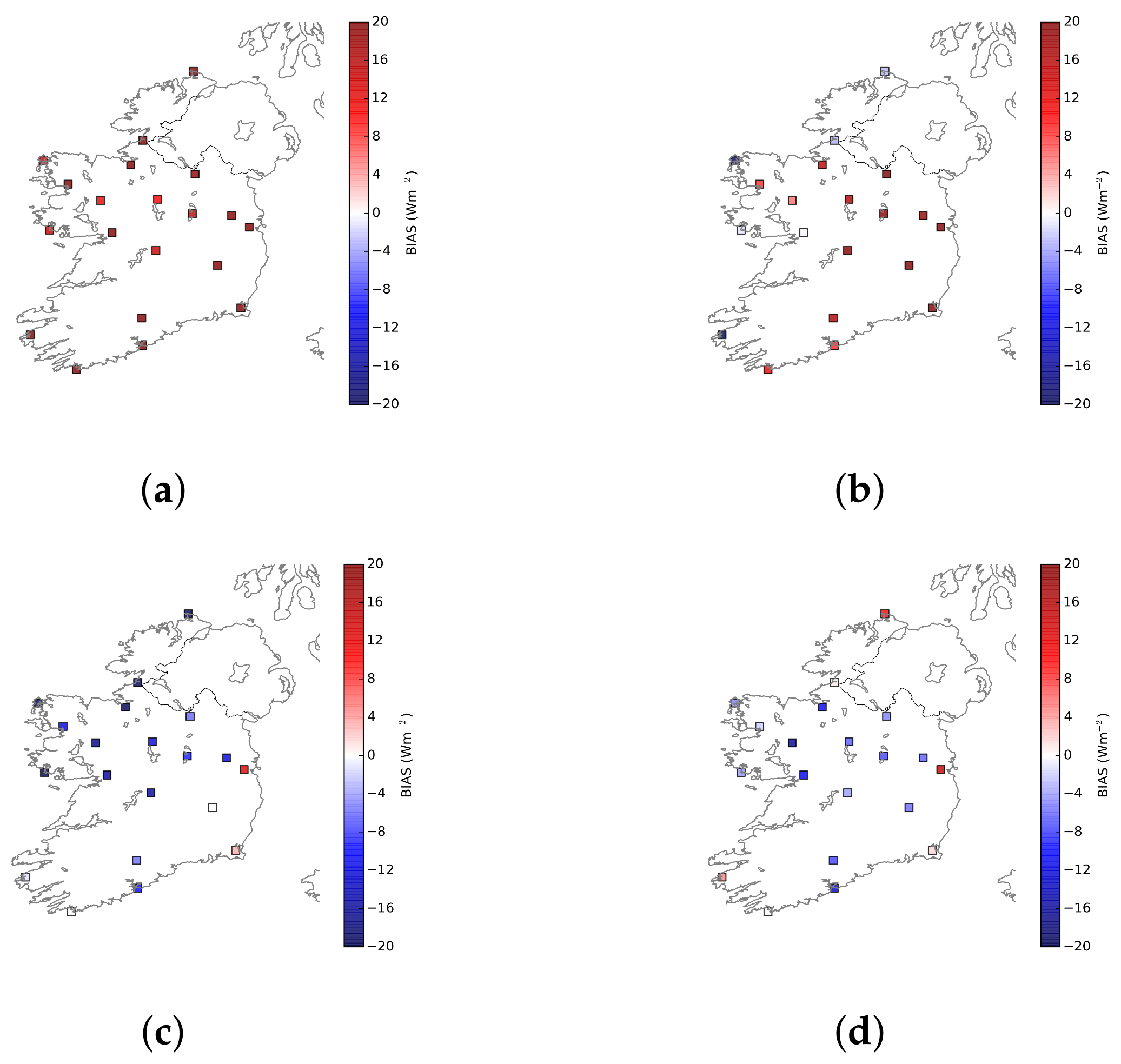
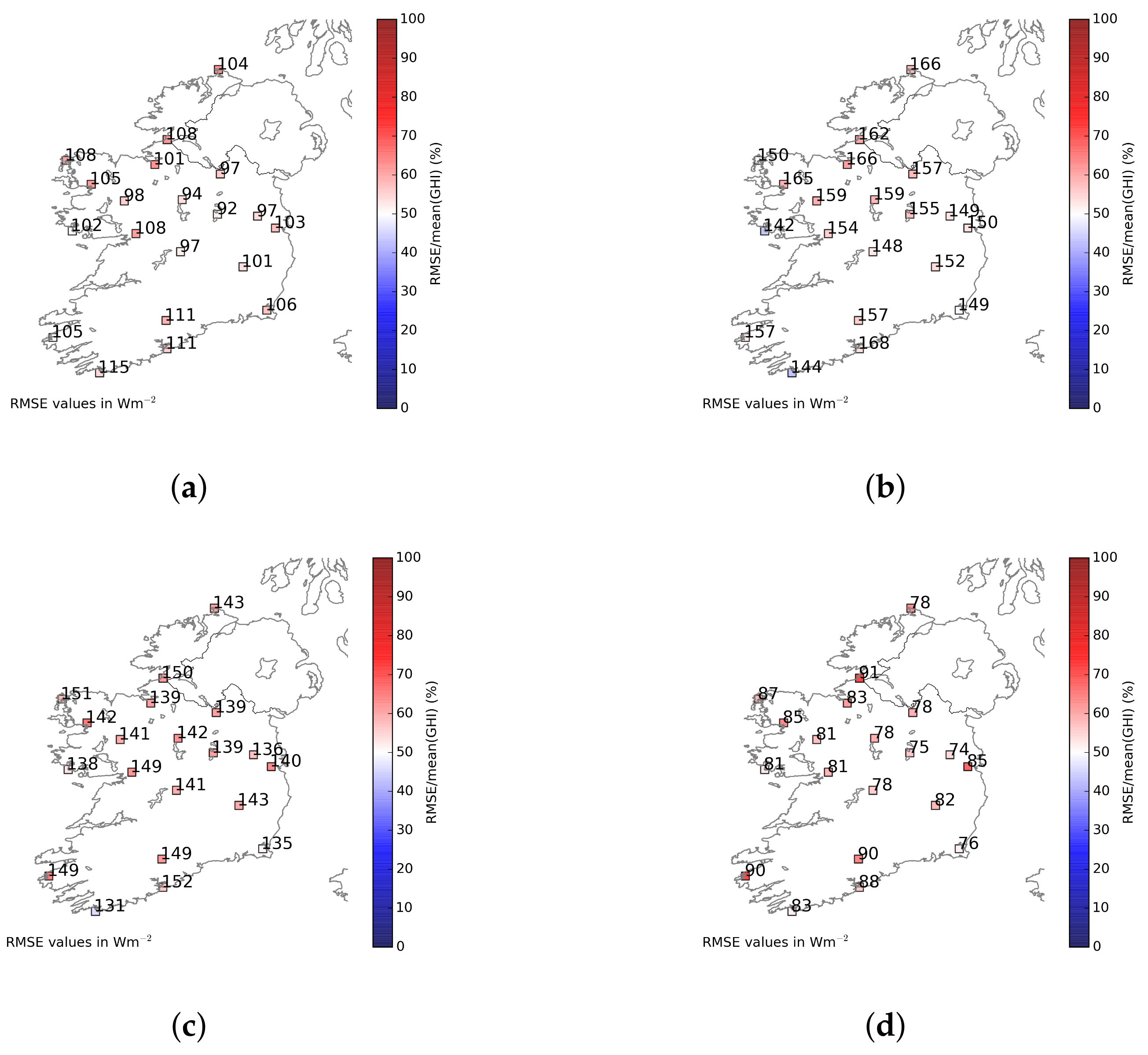
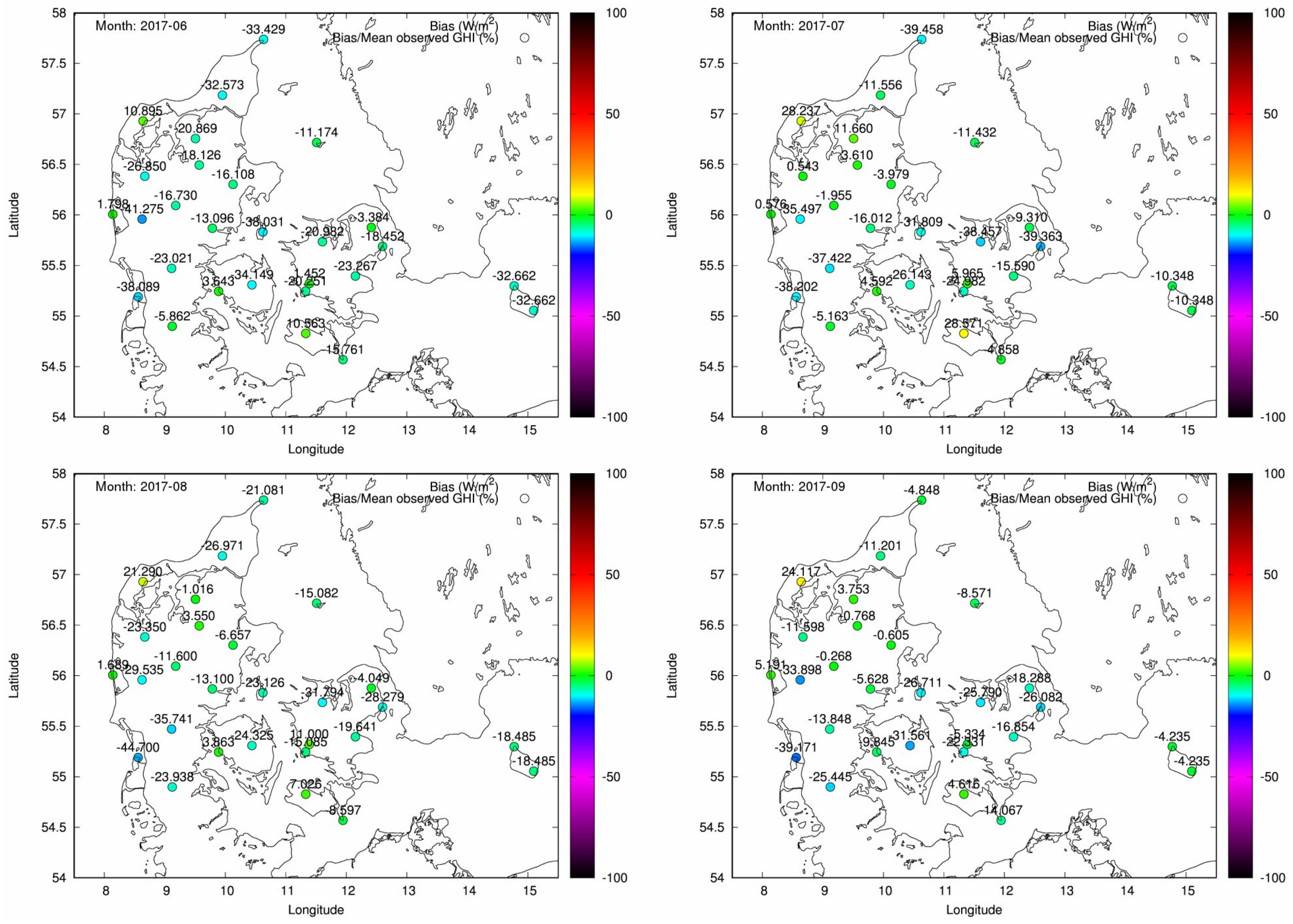
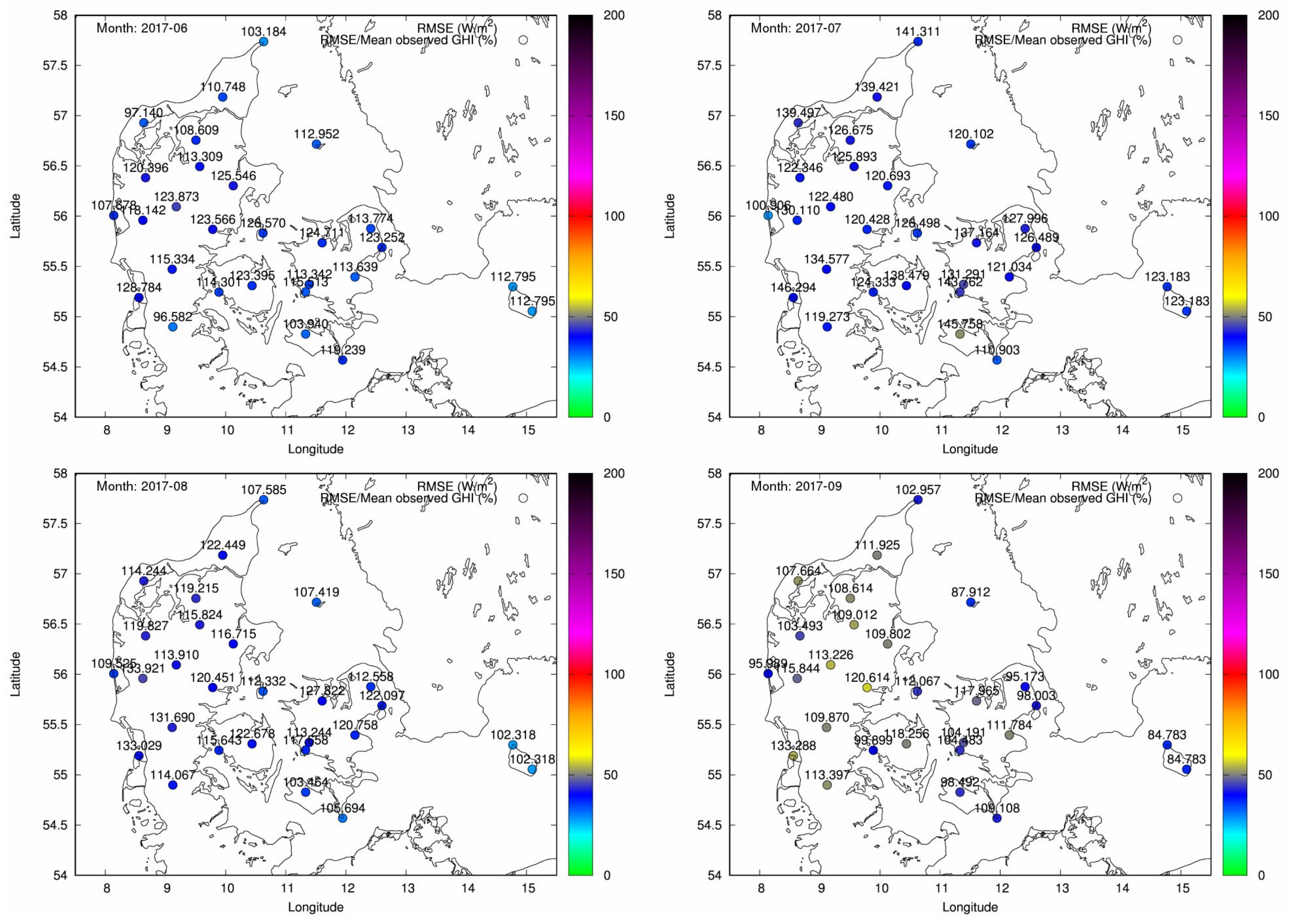
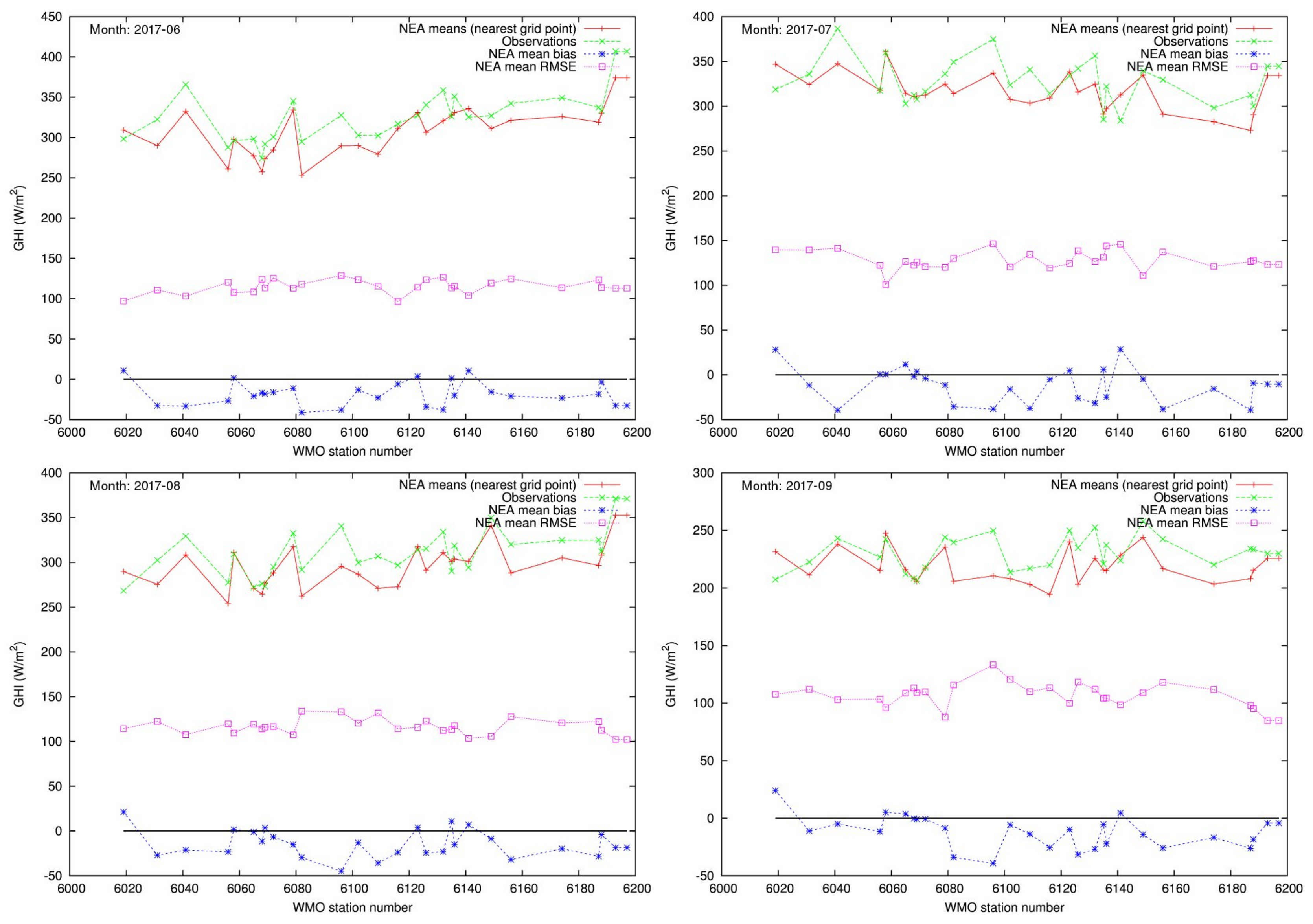
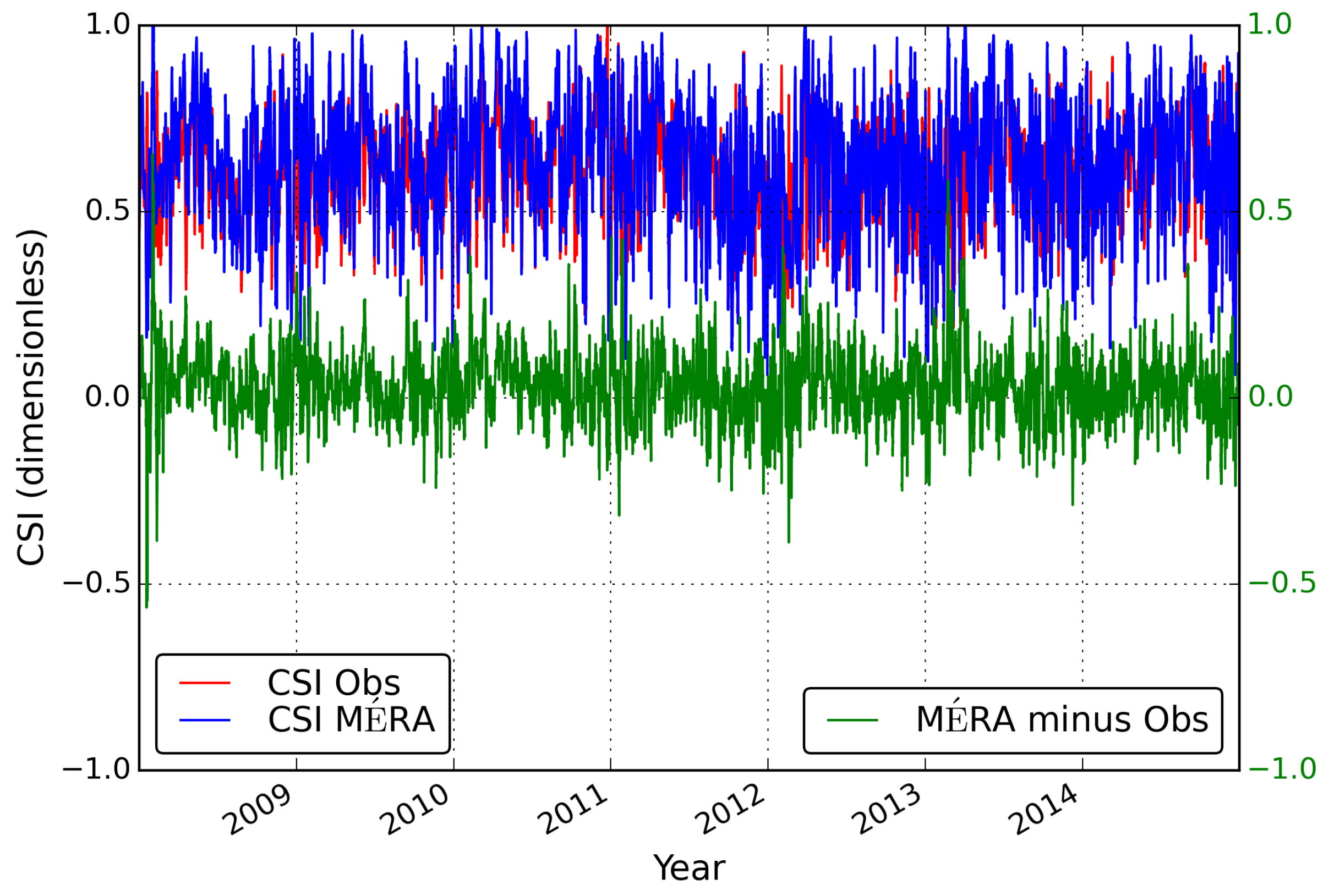

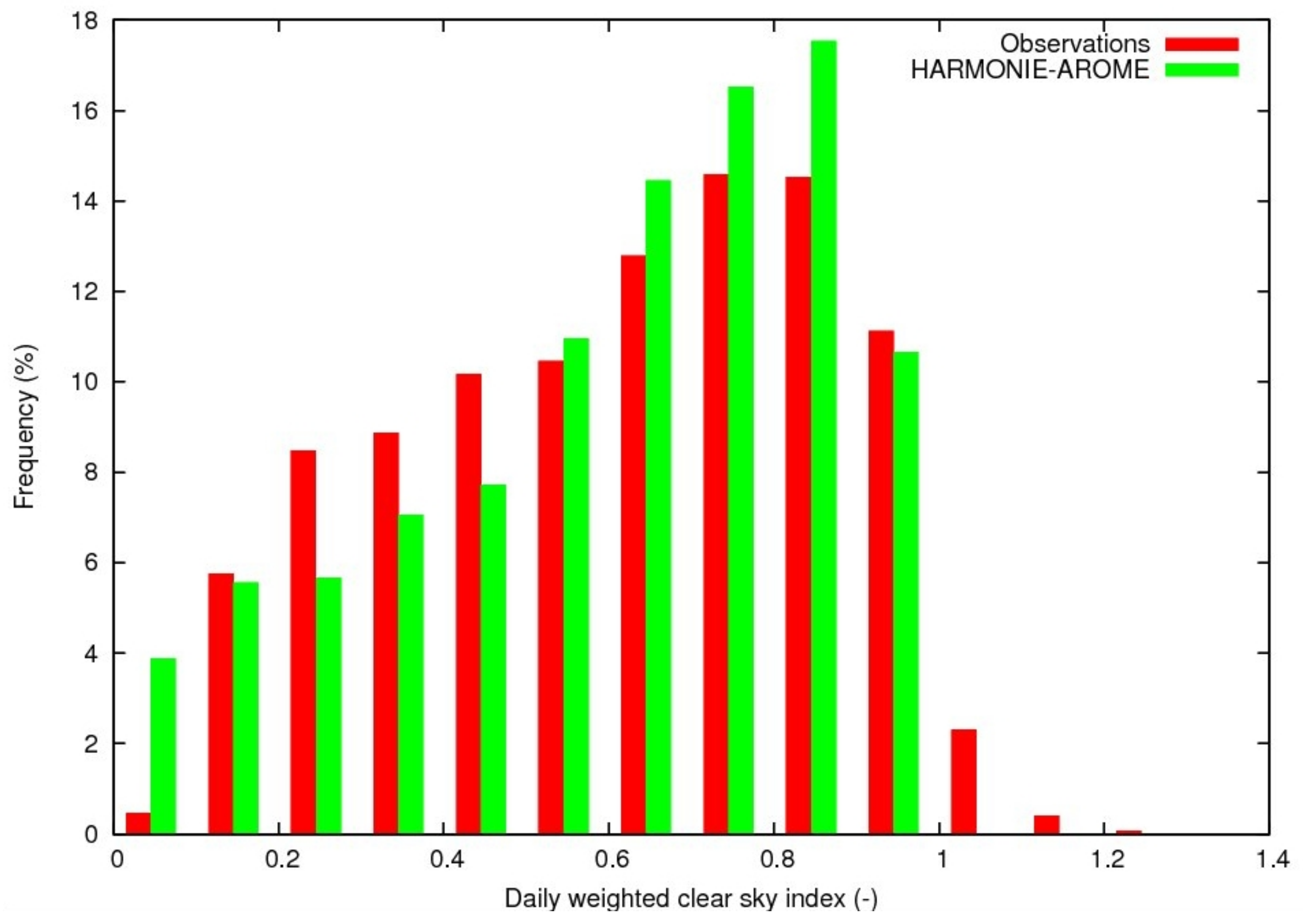
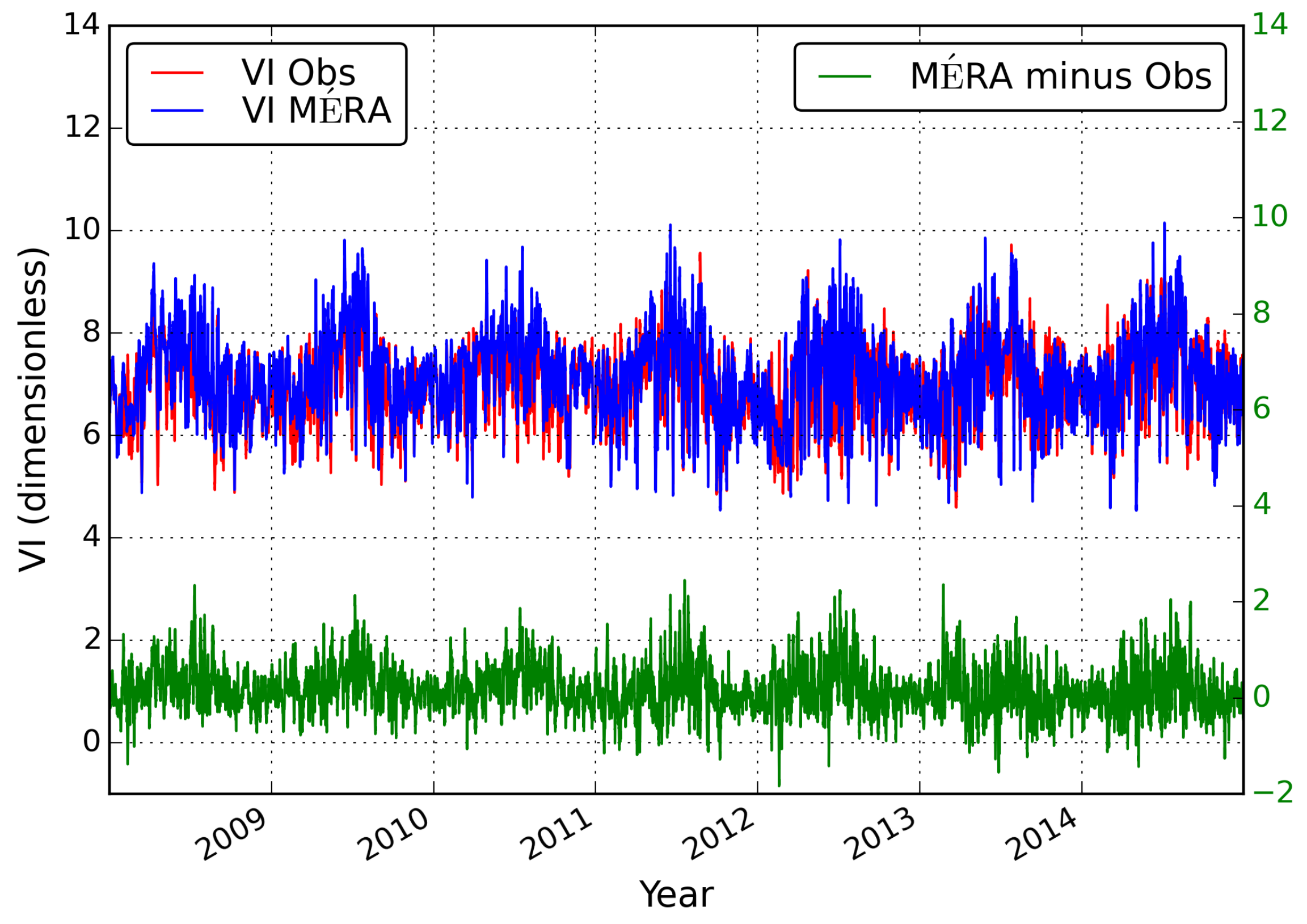

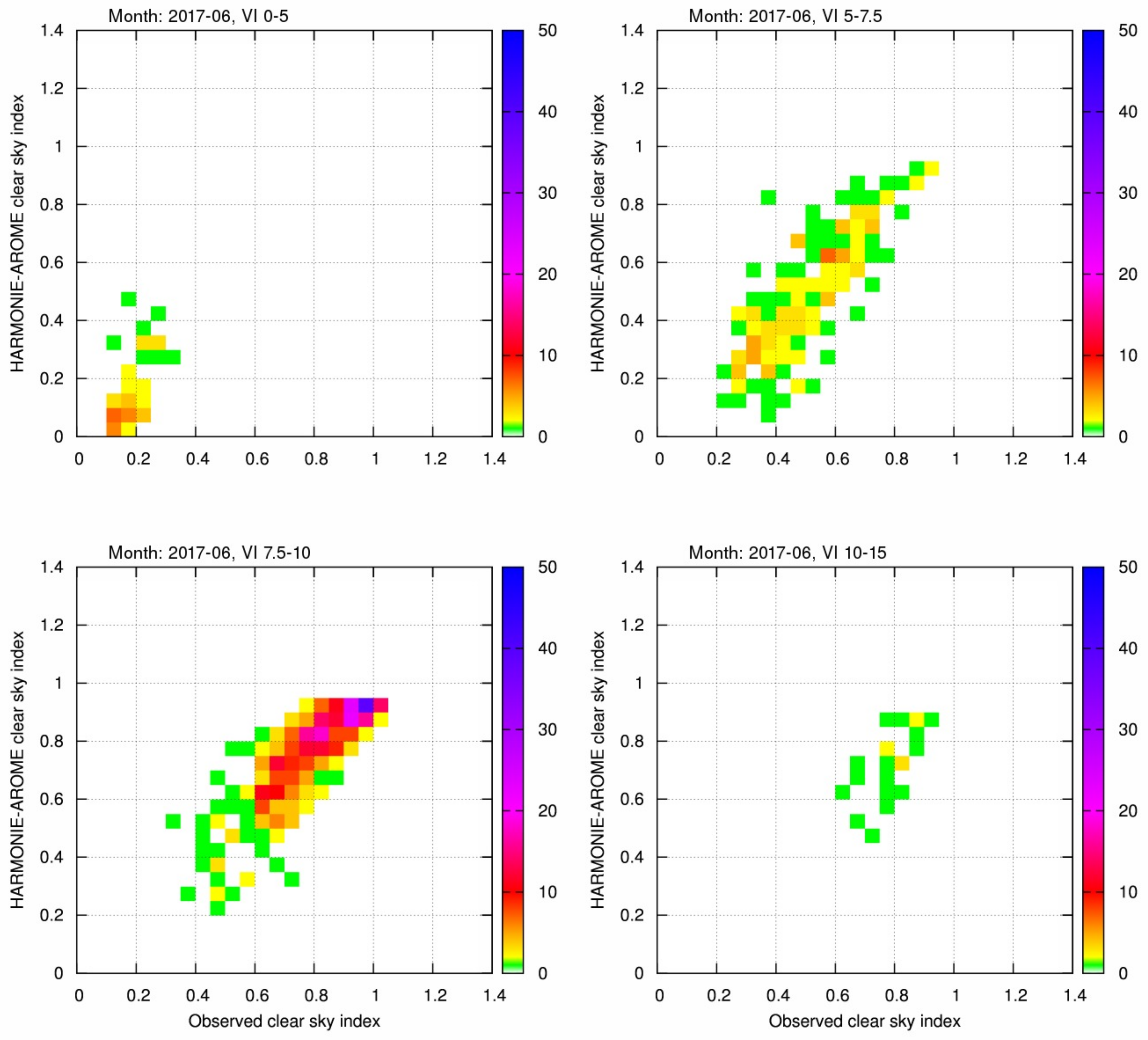
| Model Version | HARMONIE-AROME 38h1.2 |
| Domain | 540 × 500 grid points ( 2.5 km) |
| Vertical Levels | 65 levels up to 10 hPa, first level at approximately 12 m |
| Forecast Cycle | 3 h |
| Data Assimilation | Optimal interpolation for surface parameters |
| 3DVAR assimilation for upper air parameters | |
| Observations | Pressure from SYNOP, SHIP and DRIBU |
| Temperature and winds from AIREP and AMDAR | |
| Winds from PILOT | |
| Temperature, winds and humidity from TEMP | |
| Forecast | 3-h forecasts, but a 33-h forecast at 00 Z |
| Model Version | HARMONIE-AROME 40h1.1 |
| Domain | 1280 × 1080 grid points ( 2.5 km) |
| Vertical Levels | 65 levels up to 10 hPa, first level at approximately 12 m |
| Forecast Cycle | 3 h |
| Data Assimilation | Optimal interpolation for surface parameters |
| 3DVAR assimilation for upper air parameters | |
| Observations | Pressure from SYNOP, SHIP and DRIBU |
| Temperature and winds from AIREP, AMDAR and MODE-S-EHS | |
| Radiances from AMSU-A, MHS and ATMS | |
| Atmospheric Motion Vectors (AMV) from MSG | |
| GNSS-RO bending angles from Metop-A, Metop-B and COSMIC | |
| Radar volume data from OPERA | |
| Winds from PILOT | |
| Temperature, winds and humidity from TEMP | |
| Forecast | 60-h forecasts |
© 2018 by the authors. Licensee MDPI, Basel, Switzerland. This article is an open access article distributed under the terms and conditions of the Creative Commons Attribution (CC BY) license (http://creativecommons.org/licenses/by/4.0/).
Share and Cite
Nielsen, K.P.; Gleeson, E. Using Shortwave Radiation to Evaluate the HARMONIE-AROME Weather Model. Atmosphere 2018, 9, 163. https://doi.org/10.3390/atmos9050163
Nielsen KP, Gleeson E. Using Shortwave Radiation to Evaluate the HARMONIE-AROME Weather Model. Atmosphere. 2018; 9(5):163. https://doi.org/10.3390/atmos9050163
Chicago/Turabian StyleNielsen, Kristian Pagh, and Emily Gleeson. 2018. "Using Shortwave Radiation to Evaluate the HARMONIE-AROME Weather Model" Atmosphere 9, no. 5: 163. https://doi.org/10.3390/atmos9050163




